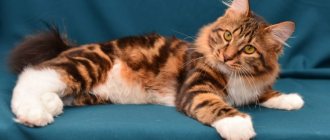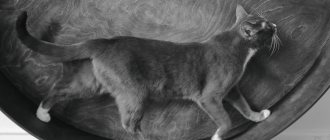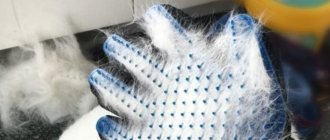Many pets are accustomed to leading an active lifestyle. At home, a loving owner needs to monitor the physical health of his pet. As it turns out, it's not just hamsters or chinchillas that need a running wheel. Recently, such a simulator has found its use among cat owners.
DIY running wheel for cats
Who would like a cat exercise machine - a running wheel?
Cats, like people, differ in character and temperament: some can spend the whole day on the couch, others need constant movement.
Passive cats play reluctantly, sleep 20–22 hours a day, are calm and slow. Active ones clearly demonstrate the hunting instinct, restlessly rush around the entire apartment, play a lot and noisily, splashing out their energy. In this they differ little from their wild relatives: in nature, such cats can cover a distance of more than 10 km at night in search of food. If every day your pet wakes you up in the morning with noisy running around, joyfully pounces on every new toy, jumps on furniture, then this definitely means that you are the happy owner of an active breed of cat. A running wheel will come in handy in a home where representatives of active breeds such as Siamese, Bengal, Abyssinian, Kurilian Bobtail, Egyptian Mau, Balinese and others live.
Cat in a running wheel
City apartments are cramped for such cats, they limit their hunting territory, so tailed fidgets endlessly run around the house, jump on windows and curtains, damage furniture, causing trouble for the owner. It is especially difficult for pets if the owners do not have the opportunity to take the cat for a walk. Cats may begin to mark their territory at home by running restlessly around the rooms. The simulator will help calm the animal and redirect attention.
The treadmill wheel is very popular in Europe, and this exercise machine has recently appeared on Russian shelves.
Now it can be purchased at any pet store, which allows every owner to take care of the health of their cat, or to make it themselves.
Benefits of a running wheel
A treadmill is similar to a human treadmill. It helps the cat lose excess weight, strengthen the cardiovascular system, muscles, and lungs.
The wheel will be useful for overweight cats and will help them get into good physical shape. Spayed and neutered cats are most susceptible to overeating. As in humans, this can lead to serious heart disease, metabolic disorders, and stress on internal organs and joints.
Together with proper nutrition, such a simulator will allow your cat to stay healthy and lose extra pounds.
The simulator can replace a scratching post. The inner covering is made in such a way that the cat can rest on it with its paws. The animal will use the running wheel when it is bored or the owner is not at home. If there are several cats in a family, then the simulator will be an excellent play complex for them.
Running on a wheel allows your cat to burn off some energy.
Description and functions
One of the items that will help diversify the life of a mustache is a running wheel for cats. At specialized sales points you can find several models of cat simulators. All of them are a round rotating object, namely a wheel of different types and sizes, with individual features in the form of lining and other details. The models differ according to the following main parameters:
- Dimensions of the simulator. Despite the fact that there are certain standards (800 and 1200 cm), you need to choose a wheel according to the size of your pet. Veterinarians and experienced cat owners recommend buying a simulator “with a reserve”, that is, more than necessary. In it, the pet will not only feel more comfortable, but will also avoid skeletal deformities.
- Inner covering material. The covering can be anything (felt, carpet), as long as the paws do not slip. Tenacious durable fabric surfaces will prevent possible injuries to the limbs.
- Design features. Some models are equipped with an additional inner wall. This type is perfect for young and active pets, whose excitement makes them forget and accelerate to such an extent that flying out of the simulator is inevitable.
You can either purchase a running wheel or make it yourself. Using the accessory will help your pet lose excess weight or prevent its appearance, strengthen muscles and joints, and prevent the development of diseases associated with lack of active activity. In addition, it will be possible to prevent domestic chaos and destruction caused by young, active and playful cats.
What types of running wheels are there for cats?
The operating principle of all running wheels is the same. The main difference is in the design and material used. Exercise machines are usually made of wood, plastic, metal or corrugated cardboard. Each material has its own positive qualities and disadvantages.
Wood is the most versatile, environmentally friendly and natural material for making cat running wheels. Most often, products made from light plywood are offered. For its basis, trees such as birch, walnut, oak, and pine are taken. The wooden exercise machine will fit perfectly into the interior of the apartment and will delight your pet every day. If you want to make a homemade wheel from wood, then keep in mind that it must first be treated to prevent rotting and its condition must be monitored.
The weight of a wooden exercise machine is from two kilograms or more
The plastic wheel is light in weight and easy to assemble at home. It is convenient to clean, but like any other thing made of plastic, such a simulator can quickly break down and repairing it will be problematic.
The plastic wheel looks aesthetically pleasing
The metal wheel is reliable, stable, durable, easy to clean, but most often it is solid and bulky, so it is inconvenient to transport. Such products are most often made by the owners themselves in home workshops.
A metal wheel is more reliable than others, but also heavier
A cardboard wheel is perfect for kittens and light weight cats. It is much easier to assemble than wood or plastic, but quickly becomes unusable. Many cats like to use cardboard objects as scratching posts, so sometimes paper scraps form next to this simulator
Cardboard wheel may not last long
Table. Comparative characteristics of materials for making wheels
| Material | Advantages | Flaws |
| Tree | Reliability, durability, aesthetics | Heavy weight, requires care |
| Plastic | Light weight, easy to assemble and clean, transportable | Fragility |
| Cardboard | Light weight, easy to assemble, transportable | Rapid wear |
| Metal | Easy to clean, no assembly required. | Heavy weight, non-transportable |
Some craftsmen use a combination of different materials to create a wheel. The resulting hybrid options are with a base made of plywood or iron and a running part made of corrugated cardboard.
By design, the wheels are either open or semi-closed. The first option assumes that the cat can enter the wheel from any side. In the closed type, one side is adjacent to the wall and is completely closed. Depending on the design option, a rotation mechanism is installed. In the open type, rotation is carried out by rollers under the wheel itself on the bottom of the stand. Such a wheel is less stable and can “walk” slightly under the weight of the cat. In the closed type, the mechanism itself that allows the wheel to spin is located on the side and allows the structure to maintain balance. If the pet is too reckless and energetic, then if he loses coordination, the side wall will be able to align his trajectory and will not allow him to fall off the wheel.
To make the cat “spin on the wheel” more actively, some models are equipped with various teasers in the form of a laser beam or a toy mouse. It is better to make such toys removable so that the cat does not get used to them.
There is a special coating inside the exercise machine to prevent the cat's paws from slipping while moving. It can be carpet, rubber, felt, foam mat. The modern market offers a choice of wheels with a wide variety of designs:
- with different wheel shapes (round, polygonal);
- with different designs for the back wall;
- different colors;
- running wheels built into play complexes;
A large play complex will give your cat a lot of positive emotions
Boxes
All cats, without exception, are partial to boxes.
If the cat can fit into the box, and even if not the whole cat fits into the box, then an ideal hiding place for ambush hunting has been found. If you approach this topic from an engineering point of view, then with a little patience and a small set of tools for woodworking, you can build a multi-level labyrinth, with stairs, boxes, tunnels and hanging hammocks, where not one, but several cats will be comfortable.
All this can be covered with soft fabric and ropes, and the product will not look awkward in the middle of the apartment. A DIY cat house of this type will undoubtedly leave an indelible mark on your pet’s soul.
How to choose a running wheel in a store?
When choosing a wheel, first of all, you need to pay attention to its size so that your pet feels comfortable. A standard wheel for medium-sized cats is considered to be a simulator with a diameter of 80 cm or more, but veterinarians advise not to skimp on the length and to purchase a wheel of 1 m or more so that the cat does not have to bend its body unnaturally and does not injure the spine. The optimal width of the treadmill is 30-40 cm.
You should pay attention to the inner shell of the simulator, on which the animal will not slip when moving. The best option for covering a cat wheel is carpet or felt.
Wheels can be solid or prefabricated. When ordering a simulator through an online store, they will send you a prefabricated wheel, which you will need to assemble yourself, piece by piece. The price for such a device varies from 10 to 25 thousand rubles. The simulator can be ordered both from Russia and abroad from individuals or in various stores.
Factory wheels will look great in any interior
DIY running wheel for cats
Cat owners often make exercise equipment for their pets with their own hands. The most common option is wooden running wheels. You can find many models of wooden exercise machines online. Most often, birch plywood or chipboard is used. Let's look at some designs.
Wooden running wheel
Model No. 1. Wooden running wheel
To make this model you will need the following materials and tools:
- plywood;
- Sander;
- double sided tape;
- rope;
- roulette;
- Miter saw;
- rollers;
- knife;
- rail;
- fasteners;
- bolts with nut;
- Dremel;
- pipes;
- bearing;
- glue;
- beam;
- pencil;
- carpet
Stage one . We will need two plywood circles with a diameter of 92-100 cm. We connect them together with bars.
Start of wheel production
Stage two. We glue the slats for the running drum around the circumference.
The process of making a running wheel requires some carpentry skills
Stage three. Cut out two semicircular platforms for the stand. For an open type of simulator, we make a rotation mechanism on a stand: we install two rollers on both sides, due to which the wheel will move.
The wheel runs on a bearing
Stage four. If you plan to make an open type of wheel, then the middle part of both plywood is cut out, and the mechanism is installed from below. All that remains is to glue the carpet to the inside. The wheel is ready. If you want to make a closed type, then cut out only one of the walls. To create a rotation mechanism, look at the following steps.
Stage five. The wheel rotates on an axle, which consists of a bolt with a bushing, so you need to increase the space for its installation. A square of plywood is glued to the back of the wall, and a decorative gear is placed on the front.
The gear can be cut out with a jigsaw or bought at a hardware store
Stage six. Let's make a stand from two boards, a support and bars for the stand. The boards themselves have pre-installed bearings.
Manufacturing and fastening of the wheel support
Stage seven. We make an internal path from carpet. You can attach it using double-sided tape or glue.
Carpet scraps can be purchased cheaply at the construction department.
Stage eight. A protective coating is applied to the finished simulator. Assembly is complete.
Model No. 2. Wooden running wheel with steel profile
There can be several variations of running wheels for cats
This version of the simulator assembly requires a welding machine. The manufacturing procedure is a little simpler than the previous one. To create a wheel you will need:
- steel profile;
- plywood;
- welding machine;
- boards;
- fasteners and wrench;
- jigsaw;
- bearings;
- wooden barrel;
- dye;
- wire;
- drill;
- roulette.
Stage one. First, the steel frame is welded: for this it is necessary to weld a rectangular steel frame onto which the wheel is attached. At a distance of 10 cm from the edge, weld a steel crossbar on the opposite side. Using a welding machine, weld two platforms for connection at the crossbar site at an angle of approximately 30-45 degrees.
Stage two. The base for the running drum is round, so it is not easy to make it by hand. A wooden barrel is best suited for these purposes, but it is advisable to bolt its boards together in advance so that they do not fall apart. For the closed wall of the wheel, cut a plywood base. It should be slightly smaller than the inner diameter of the barrel.
Stage three. Having dealt with the drum and the back wall, you can begin assembling the structure of the treadmill, painting the drum with paint in advance. We connect the bushing and the drum with bolts so that the wheel can rotate freely without deviation to the left or right.
Model No. 3. Running wheel based on a bicycle one
Bicycle wheel for cats
The running wheel, which operates like a bicycle wheel, can support the weight of two adult cats and can be installed on any surface. The wooden drum has a diameter of 100-110 cm. Using the same principle, you can make a metal wheel with your own hands using a welding machine.
Reliable design, but requires metal welding skills
Model No. 4. Cardboard running wheel
This version of a homemade simulator is the simplest and most economical; assembly takes much less time. To work you will need:
- corrugated cardboard;
- glue or double-sided tape;
- professional knife for cutting cardboard;
- scissors;
- a rag made of cotton fabric;
- carpet
Stage one. Cut out a rectangular area for the stand. Glue perpendicularly with three pieces of cardboard, curved under the wheel area. Pre-cut identical holes on the sides of the curved parts for the rollers, close the structure on both sides.
Cardboard blank
Stage two. Attach the roller to the sleeve on one side and push it through the holes in the structure, placing the bolts on the sleeve so that they come into contact with the cardboard. Put on the second video. Perform the same operation on the other side of the rack.
Connecting parts
Stage three. Prepare the covering surface of the structure by first wetting it with a wet cloth. Separate the skin of the cardboard from its main part. As a result, we get a soft surface that rests quietly on the edges of the structure, completely covering it from above.
We continue to work
Stage four. We cut out four identical rings with a diameter of 46 cm and a thickness of approximately 3-4 cm. Place the first pair of rings on top of each other and use the soft part of the separated corrugated cardboard, placing it along the entire inner diameter. Place the remaining pair of rings on top of the cardboard.
The work is moving towards completion
Stage five. We connect the resulting wheel to the stand and glue the carpet track with double-sided tape. The wheel is ready!
Video - Cardboard cat trainer
How to train a cat to ride a wheel?
Don't expect your cat to spin a wheel all day long, like a hamster or a squirrel. The respiratory system of a cat is designed in such a way that it can withstand maximum load for 30-40 seconds. This is exactly how much it takes for a cat in the wild to catch its prey. They spend the rest of their time tracking and lying in wait for their prey. To understand the delights of running in wheel to wheel, the cat needs to get used to and examine the new furniture, not be afraid of the noise and movement of the wheel itself.
The first step is to move your games that you usually play to the area of the wheel or to the room where it is located. Use a laser, mouse, bell, or other teaser to get your cat to step onto the treadmill several times. It will take 2-3 days to get used to the simulator. Hang the toy on the side of the drum, above the cat's reach. In pursuit of the toy, the cat will make several movements and the wheel will begin to rotate. If this works, then after 10-15 seconds let the cat take possession of the toy. If the cat gets scared of the wheel and jumps out of it, then you need to continue playing near the simulator without rewarding the cat with a toy.
Physical activity is extremely important for cats
Over time, your pet will get used to the wheel and playing inside it. Do not forget that at the end of the hunting game the cat must get what she wants. Veterinarians advise not to keep your cat constantly excited and to give it rest between games to regain its strength.
Soft toy
To make such a toy you need to have some skills in working with a sewing machine, or good perseverance when sewing by hand. The most traditional in this regard is the mouse.
To create this toy at home you will need:
- quite dense fabric;
- interlining;
- stuffing material;
- pattern (can be found on the Internet);
- threads;
- sewing machine.
Or be patient and do all the work manually.
Along with the pattern you will also find detailed sewing instructions. And if you place a Kinder egg with grain inside the mouse, your mouse will also rattle.











